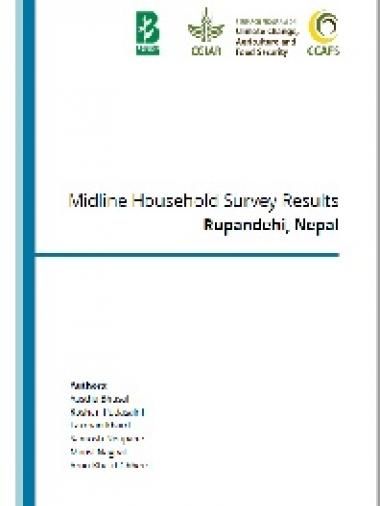Midline Household Survey Results: Rupandehi, Nepal

This report summarizes the main findings from the household midline survey conducted in seven villages of the district of Rupandehi, one of CCAFS site, in Nepal in July 2019. The household survey revisited the 135 households of the 2012 CCAFS baseline survey and used the same standardized household survey tools. The Open Data Kit (ODK) software was used for the data collection.
The results show that the majority of households in Rupandehi produce a variety of crops, among which rice, wheat and mustard. Many farmers also rear livestock such as cows, buffalo, chicken, oxen and goat. All members of the family typically engage in the on-farm agricultural work but men are more likely to be also involved in off-farm activities. Households members derive their income from a variety of sources, the main one being payments from the government or other projects/programs. This is followed by remittances and income from businesses as the main alternative income sources for many households. Moreover, most of the farmers have made changes in their agricultural practices since the baseline. Many have introduced higher-yielding crop varieties or have stopped keeping one or more types of animals on the farm.
In terms of food security, the majority of the households surveyed in Rupandehi district are food secure throughout the entire year. The households mostly obtain their food directly from their farms. However, some of the households purchase food from other sources, especially during the month of June, July and August. Most farmers are small landholders, almost 75% of the households’ land sizes are marginal (< 1 ha), followed by a minority of smallholders owning between 1 and 2 ha of land. 98% of the households indicated buying seeds and inorganic fertilizers whereas 95% of households reported the purchase of pesticides and insecticides. 70% of households also recorded the purchase of veterinary medicine.
According to the survey, television, cell phone and bicycle are the most common assets in the area. Internet access is also common in many households. Women are mostly involved in crops cultivation, mainly vegetables and cereals along with rearing livestock. The farmers have shifted towards higher-yielding and better-quality varieties of rice, and wheat. The survey findings indicate that farmers are well aware of agricultural innovations and tend to use new crop varieties.
Citation
Bhusal A, Pudasaini R, Khatri L, Neupane S, Nagpal M, Khatri-Chhetri A. 2020. Midline Household Survey Results: Rupandehi, Nepal. CCAFS Report. Wageningen, the Netherlands: CGIAR Research Program on Climate Change, Agriculture and Food Security (CCAFS).